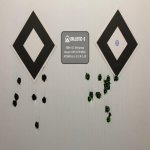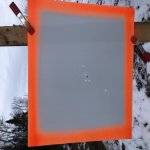Got out again today and I’m still chasing a good load for my 6.5 Creedmoor and 140gr ELDM.
Magnetospeed sure does change POI and now I’m certain it affects group size. However, there is a conundrum: when doing load development we are relying on such a small sample size that we might get caught by chance and land on a load that we probably shouldn’t use.
For example:
My initial load development suggested 40.0 (2468 FPS, ES of 1), 40.6 (2498 FPS, ES of 2) 41.2 (2540 FPS, ES of 3) and 43.0 (2640 FPS, ES of 7). I went with the fastest velocity. I’ve now fired 43.0gr of H4350 a total of 23 times over 3 range and 3 reloading sessions. The average remains 2662 PFS but the ES has grown to 71 with an SD of 20. My targets haven’t been very impressive either with this load:
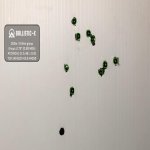
The lowest bullet hole wasn’t pulled and the Magnetospeed gave a velocity of 2561 FPS. No clue what happened there and I didn’t include it in my data output.
I also tried 42.5 hoping for a load with a more narrow ES. The data came in pretty decent but I’ve only got a sample size of 5 (2632 FPS, ES of 14) but a pretty crappy target:
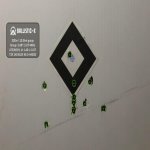
After realizing I was probably back to the drawing board, I took off the Magnetospeed and played around at different distances with the remaining ammo. I had a couple of surprising misses which made me wonder about the impact of the ES. However the last 5 rounds of the day pulled off this group at 600m:
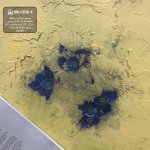
Either I got really lucky and the large ES didn’t rear its ugly head, or, the other groups would have been much smaller without the Magnetospeed. At the end of the day I’m a bit frustrated chasing these numbers and burning powder, ammo and barrel life. I’m tempted to drop back down to the 40s or 41s and see if I have better luck with the ES problem. I was as careful as I could be reloading so hopefully the problem doesn’t lie there. I’d rather have good vertical consistency with a lower velocity and take my chances with the wind.
Any thoughts out there on what I could improve or a load I should be trying?
Magnetospeed sure does change POI and now I’m certain it affects group size. However, there is a conundrum: when doing load development we are relying on such a small sample size that we might get caught by chance and land on a load that we probably shouldn’t use.
For example:
My initial load development suggested 40.0 (2468 FPS, ES of 1), 40.6 (2498 FPS, ES of 2) 41.2 (2540 FPS, ES of 3) and 43.0 (2640 FPS, ES of 7). I went with the fastest velocity. I’ve now fired 43.0gr of H4350 a total of 23 times over 3 range and 3 reloading sessions. The average remains 2662 PFS but the ES has grown to 71 with an SD of 20. My targets haven’t been very impressive either with this load:

The lowest bullet hole wasn’t pulled and the Magnetospeed gave a velocity of 2561 FPS. No clue what happened there and I didn’t include it in my data output.
I also tried 42.5 hoping for a load with a more narrow ES. The data came in pretty decent but I’ve only got a sample size of 5 (2632 FPS, ES of 14) but a pretty crappy target:

After realizing I was probably back to the drawing board, I took off the Magnetospeed and played around at different distances with the remaining ammo. I had a couple of surprising misses which made me wonder about the impact of the ES. However the last 5 rounds of the day pulled off this group at 600m:

Either I got really lucky and the large ES didn’t rear its ugly head, or, the other groups would have been much smaller without the Magnetospeed. At the end of the day I’m a bit frustrated chasing these numbers and burning powder, ammo and barrel life. I’m tempted to drop back down to the 40s or 41s and see if I have better luck with the ES problem. I was as careful as I could be reloading so hopefully the problem doesn’t lie there. I’d rather have good vertical consistency with a lower velocity and take my chances with the wind.
Any thoughts out there on what I could improve or a load I should be trying?



















































